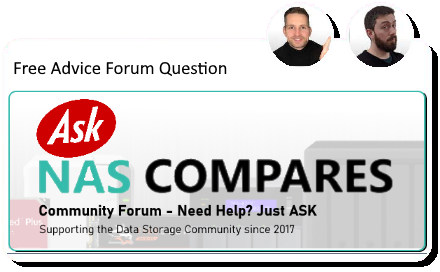Posts: 1,071
Threads: 1,072
Joined: Feb 2020
Reputation:
2
Hello! New NAS setup, primarily to replace icloud for family. I am accessing QuMagie from tailscale, since I still want to view photos and videos away from home.
Videos in particular have a lag/buffering time. What would you recommend to optimize speed? Accessing on PC via LAN seems quick enough
1.Would an SSD cache help?
2. Would migrating the app to SSD help? (do I need specific size to ensure this works)
3. Open to other options, I'm not experienced with docker, but can try to learn if its specifically a QuMagie issue
Posts: 5,379
Threads: 2
Joined: Jun 2022
Reputation:
35
1. SSD Cache
Adding an SSD cache can indeed help speed up access times for frequently accessed data. Since you're using large HDDs, a fast SSD cache can speed up read/write operations and reduce buffering, especially for media like videos.
Recommendation: If your NAS supports SSD caching (like the TS-464), consider adding a high-performance SSD (e.g., NVMe or SATA SSD). This can significantly boost read performance, especially for remote access.
Important: SSD cache is most effective when you're accessing the same files repeatedly. It won't help much for random or one-time accesses.
2. Migrating QuMagie to SSD
Migrating the QuMagie app to an SSD could potentially improve app performance, but it's not a guaranteed fix for video streaming issues. The lag you're experiencing might be due to the video files themselves being accessed from HDDs rather than the app’s backend, which resides on the SSD.
Recommendation: If you decide to move QuMagie to an SSD, a 120GB or 250GB SSD should suffice. However, the main benefit might be app load times and not necessarily video streaming performance.
3. Other Optimization Options
Since you're using Tailscale, here are a few other considerations:
Network speed: The lag could also be due to bandwidth limitations over the internet, especially when you're away from home. You could try testing with higher-quality VPN solutions or ensure that you have a fast upload speed from your home network.
Transcoding settings: Check if QuMagie is transcoding videos when streamed. Transcoding on the fly can create buffer delays, especially for larger files. You could adjust transcoding settings or ensure your video formats are compatible with your devices to avoid transcoding.
Tailscale settings: Ensure Tailscale is routing traffic over the best possible path, as sometimes VPN connections can introduce overhead, particularly if the VPN server or exit node isn’t optimized for speed.
4. Using Docker (Optional)
You mentioned being open to Docker, but since you’re not experienced with it, it might not be worth diving into unless you’re comfortable with managing containers. If QuMagie is working well locally but you’re seeing issues remotely, Docker won’t necessarily resolve the buffering but could be a way to better manage resources if you decide to try other services or tweak QuMagie’s performance further.





